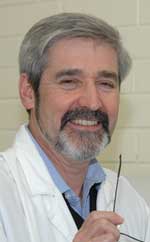Western Australia
July 24, 2008
|
 |
|
Mottling and distortion on leaves of native wisteria
(Hardenbergia comptonia) due to Hardenbergia mosaic
virus, first discovered by researchers at the WA State
Agricultural Biotechnology Centre, Murdoch University. |
Movement of viruses between native
plants and introduced crops is being investigated in a new
research project focusing on WA’s South West Australian
Floristic Region (SWAFR).
According to Professor Mike Jones, Director, WA
State Agricultural
Biotechnology Centre (SABC), Murdoch University, the SWAFR
represents a unique interface between an ancient ecosystem and
modern agriculture.
“It is one of 34 international
‘hot spots’ of global diversity and endemic plant species.
“Unlike Eurasia where agriculture has occurred for thousands of
years, agriculture has only existed in WA for 150 years,”
Professor Jones said.
“This provides the opportunity to
investigate encounters where plant viruses present in native
plants can move into crop plants and vice versa.”
SABC Senior Postdoctoral Fellow, Dr Stephen Wylie and colleagues
at the SABC and Department of Agriculture and Food WA (DAFWA)
discovered the first new virus identified from an indigenous
plant in this region, naming it Hardenbergia mosaic virus.
“This virus infects the native wisteria, Hardenbergia comptonia,
causing mottling and distortion of the leaf and may affect its
ability to persist in the wild,” he said.
“Viruses are usually transported via a vector from one plant to
another and the vector can be an insect, pollen, soil fungus or
the mechanical action of animals.
“We know from glasshouse experiments that this new virus can
readily infect lupins.”
|
 |
|
Professor Mike Jones, Director, WA State Agricultural
Biotechnology Centre. |
According to Dr Wylie, native
wisteria often grows around the margins of lupin crops and
Hardenbergia mosaic virus therefore has the potential to infect
lupin, an important rotation crop in WA, which is the world’s
largest lupin producer.
Another concern is that commercial nurseries which propagate
plants or re-vegetate degraded natural areas could inadvertently
spread viruses within the nursery, which could then be
transferred back into the natural environment.
“Monoculture conditions in the nursery provide a perfect ’green
bridge’ that may make it easy for vectors to survive and pass on
viruses,” Dr Wylie said.
“So far, we’ve only found one indigenous virus that has evolved
in WA’s south west, but with more than 12,000 endemic plant
species in WA it undoubtedly represents the tip of the iceberg.
“Because of the region’s isolation over millions of years, it’s
probable that there are many undescribed families of viruses yet
to be discovered.”
Dr Wylie emphasised the importance of considering how climate
change might affect the ranges of indigenous and introduced
plants and insects, creating new conditions for the transfer of
disease.
“It’s also possible that ecosystem stress could cause viruses of
introduced plants to move into native plant communities and we
have evidence that this is already happening.
“Similarly, native viruses could emerge from the flora and be
transmitted into crop species, creating epidemics.
“We know this has already occurred with deforestation in Brazil
and Africa, where insect vectors have caused outbreaks of
previously unknown gemini viruses to move from forest plants
into tomatoes and maize and seriously impact crop production,”
he said.
The research is now funded by an Australian Research Council
Linkage Project, supported by the SABC, Saturn Biotech, Worsley
Alumina, ALCOA, Kings Park and Botanic Gardens and DAFWA. |
|